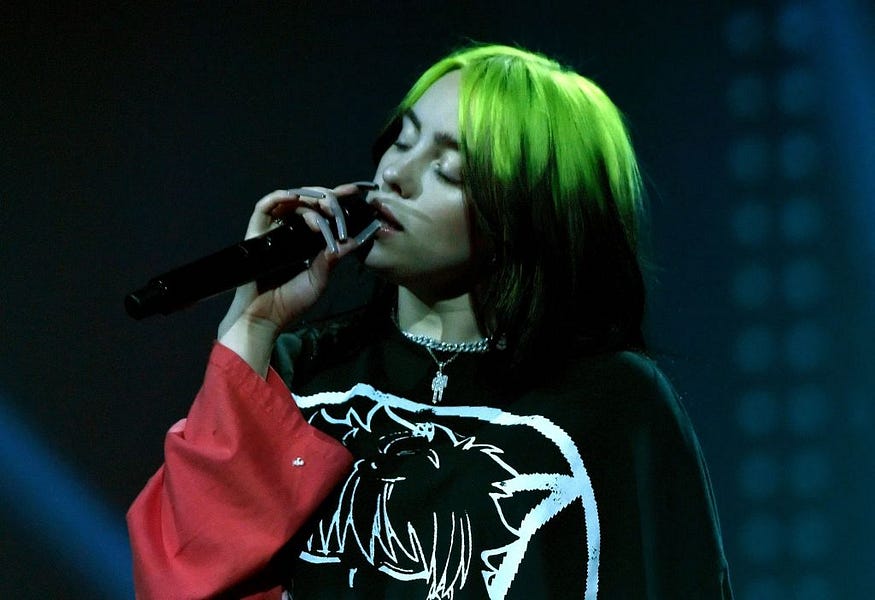For 19-year-old electropop singer Billie Eilish, stardom is about more than just the music. Every aspect of the pop star’s persona—from her baggy, skater boy clothes to her wild hairdos—aims to test the bounds of mainstream culture. In stark contrast with rival female artists like Ariana Grande or Taylor Swift, Eilish opts not to wear much makeup, even onstage. Her soprano voice is light, breathy, and—unlike her emotions—always in control.
Director R.J. Cutler (The War Room, The September Issue) tracks the singer-songwriter’s eccentricities in his new Apple TV+ documentary, Billie Eilish: The World’s A Little Blurry. This coming of age tale catalogs Eilish’s rise to fame as she and her brother write and perform her 2019 debut album When We All Fall Asleep, Where Do We Go? on tour. A tasteful patchwork of backstage concert shots and blurry home videos filmed mostly between 2018 and 2020, the documentary tracks the pop star’s emotionally turbulent journey from her 2015 SoundCloud hit “Ocean Eyes” to her sweep of the four major Grammy categories just five years later.
The documentary provides fans a sneak peak of Eilish’s songwriting routine with her older brother and co-producer Finneas—a process Eilish openly “hates”—where the audience becomes a fly on the wall as the two improvise harmonies, test out lyrics, and play with dynamics in Finneas’ childhood bedroom, the duo’s favorite recording spot. At one point in the film, Eilish flips through her songwriting book, where the audience gets a glimpse of the somewhat disturbing doodles that accompany her lyrical stream of consciousness.
“In the future I’m gonna do stuff with wings,” Eilish tells the camera as she points to a feathered creature she’d scrawled in pencil at one point. “Then I also wanna do something where I drink black liquid and then my eyes turn black and then I start bleeding black out of my eyes.” (Both ideas later came to fruition in the music videos for “When the Party’s Over” and “All the Good Girls Go to Hell.”)
Finneas, who is often pictured smirking at his sister’s wacky ideas, comes across as the driving force of his sister’s success: Eilish is the erratic and depressive half of their sibling duo that can only be fully charged by Finneas’ patient optimism and unshakable faith in their success. At one point, the two argue over a song Eilish doesn’t want to put on the album. “It’s just like everything else we’ve written,” Eilish tells her brother.
The scene highlights one of the core themes in Eilish’s emotional development: her constant fear that writing an “accessible” hit will make her just another cog in the mainstream machine. This obsession with her Internet persona comes to a head during a backstage meet-and-greet, where an exhausted Eilish is pressured by her mother to meet a group of so-called “randos” post-performance.
“I don’t want anyone who knows who I am or is any sort of fan or knows a fan to see me in any sort of awkward situation,” Eilish tells her family and her tour team after the encounter. “It’s embarrassing, and I have to keep smiling, and if I don’t, they hate me and think I’m terrible.” The scene is uncomfortable for everyone involved. Eilish’s mother apologizes profusely for failing her daughter as the rest of the team sits in awkward silence at the back of the tour bus.
Conservative culture critics have sought to portray the Gen Z pop star as a social media obsessed, homeschooled brat who glorifies depression and embraces cynicism. Cutler tacitly acknowledges these criticisms in Blurry, where Eilish is pictured having a falling out with a music video director after a directorial mishap induces what she calls a “tic attack,” her code phrase for a Tourette’s syndrome flare-up. She’s later shown complaining to her brother about an upcoming album deadline: “I sound horrible and I can’t sound good ‘cuz I’m not good.”
The director’s decision to broadcast Eilish’s impatient attitude and snarky eyerolls to the big screen are all to remind her critics that she wrote this record-smashing album when she was just a kid. Cutler takes pains to remind us of this fact: The film captures Eilish dancing in front of the DMV celebrating her new learner’s permit, pining over a boy, joking about her Invisalign, and crying while meeting her childhood crush, Justin Bieber, for the first time.
But Cutler also captures the teen’s ability to deal with traumatizing career fumbles at such a young age, from forgetting the lyrics to a new song at Coachella to spraining her ankle onstage in front of thousands of fans in Milan. In some sense, Eilish’s hair-color changes throughout the film—white to gray to light blue to dark blue to teal to jet black with a splotch of neon green on top—track the singer’s ability to weather these challenges over time.
The documentary does drag on at times, featuring intimate family arguments and uninterrupted concert performances that necessitate an intermission at the 1 hour, 15 minute mark. But Eilish’s own songs thread the film together, reminding viewers of the pop star’s resilience in spite of the inner turmoil that seems to go hand and hand with her success.







Please note that we at The Dispatch hold ourselves, our work, and our commenters to a higher standard than other places on the internet. We welcome comments that foster genuine debate or discussion—including comments critical of us or our work—but responses that include ad hominem attacks on fellow Dispatch members or are intended to stoke fear and anger may be moderated.
With your membership, you only have the ability to comment on The Morning Dispatch articles. Consider upgrading to join the conversation everywhere.